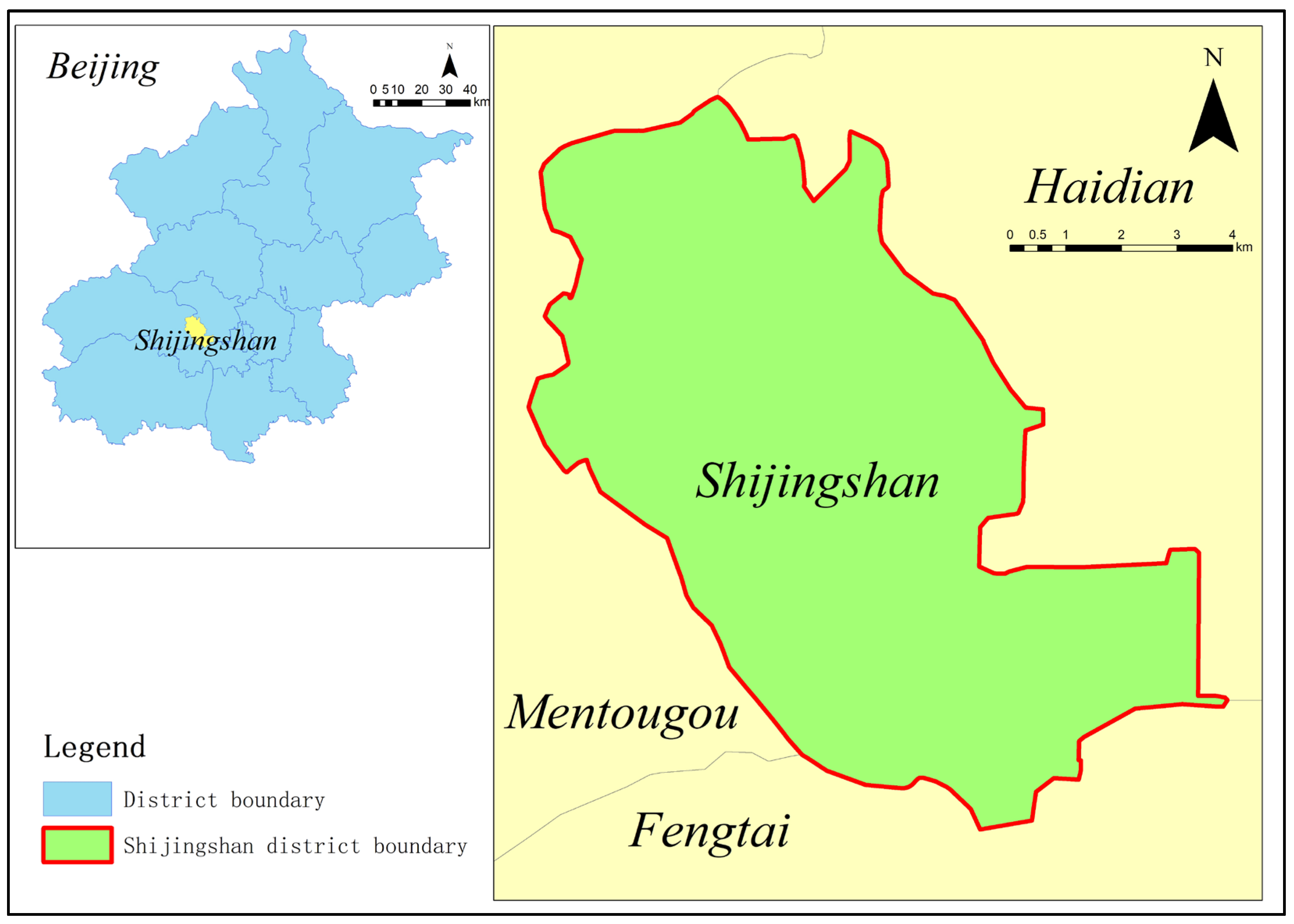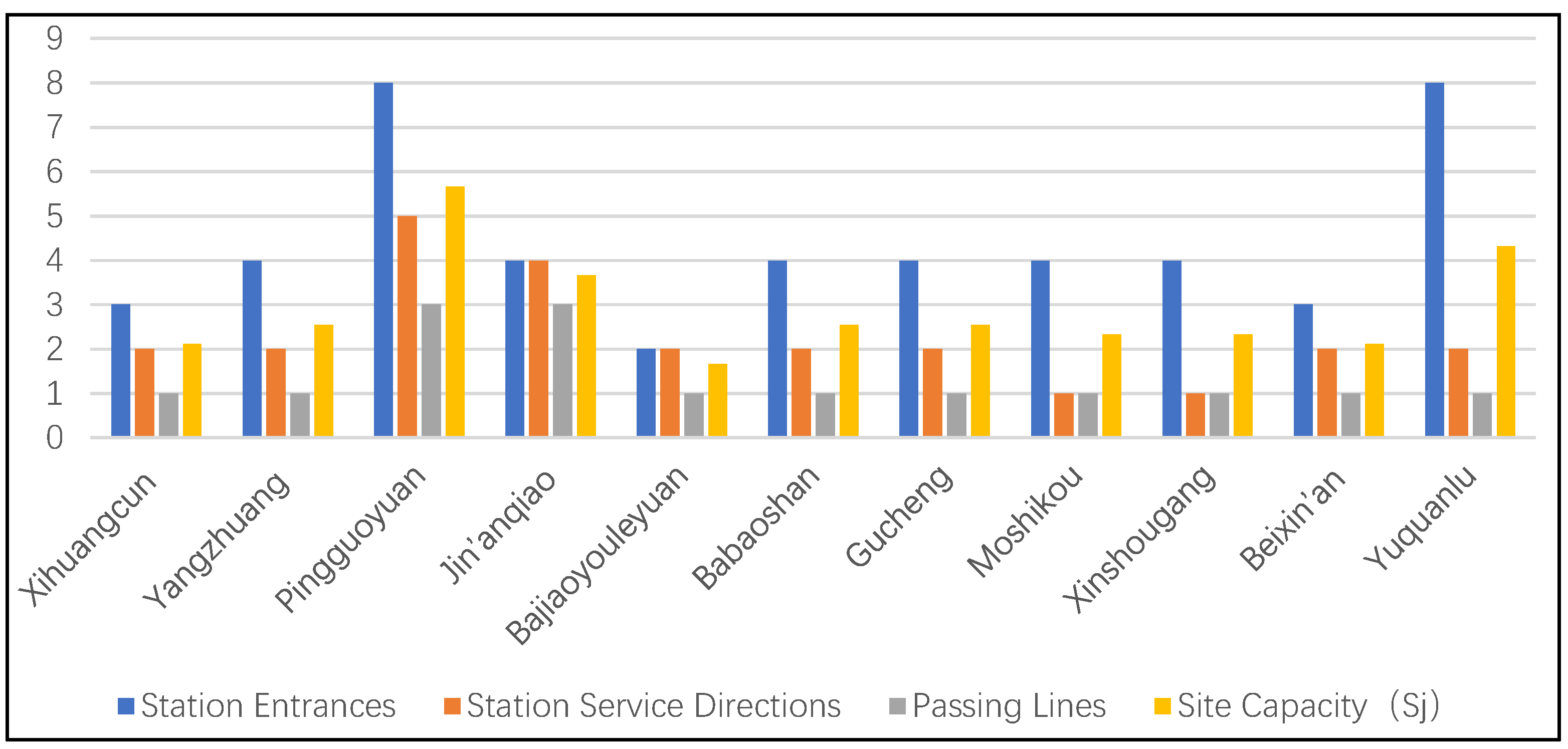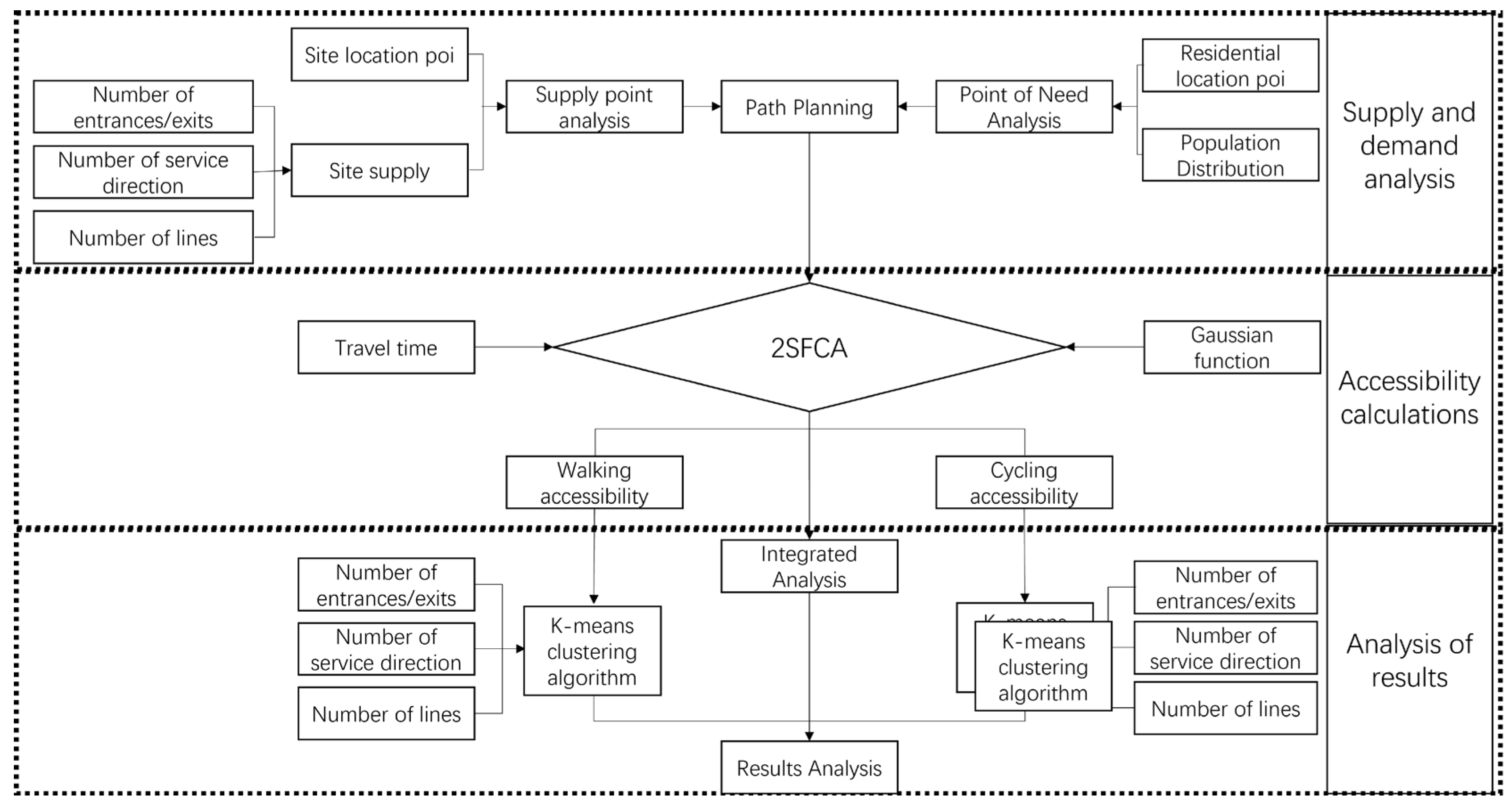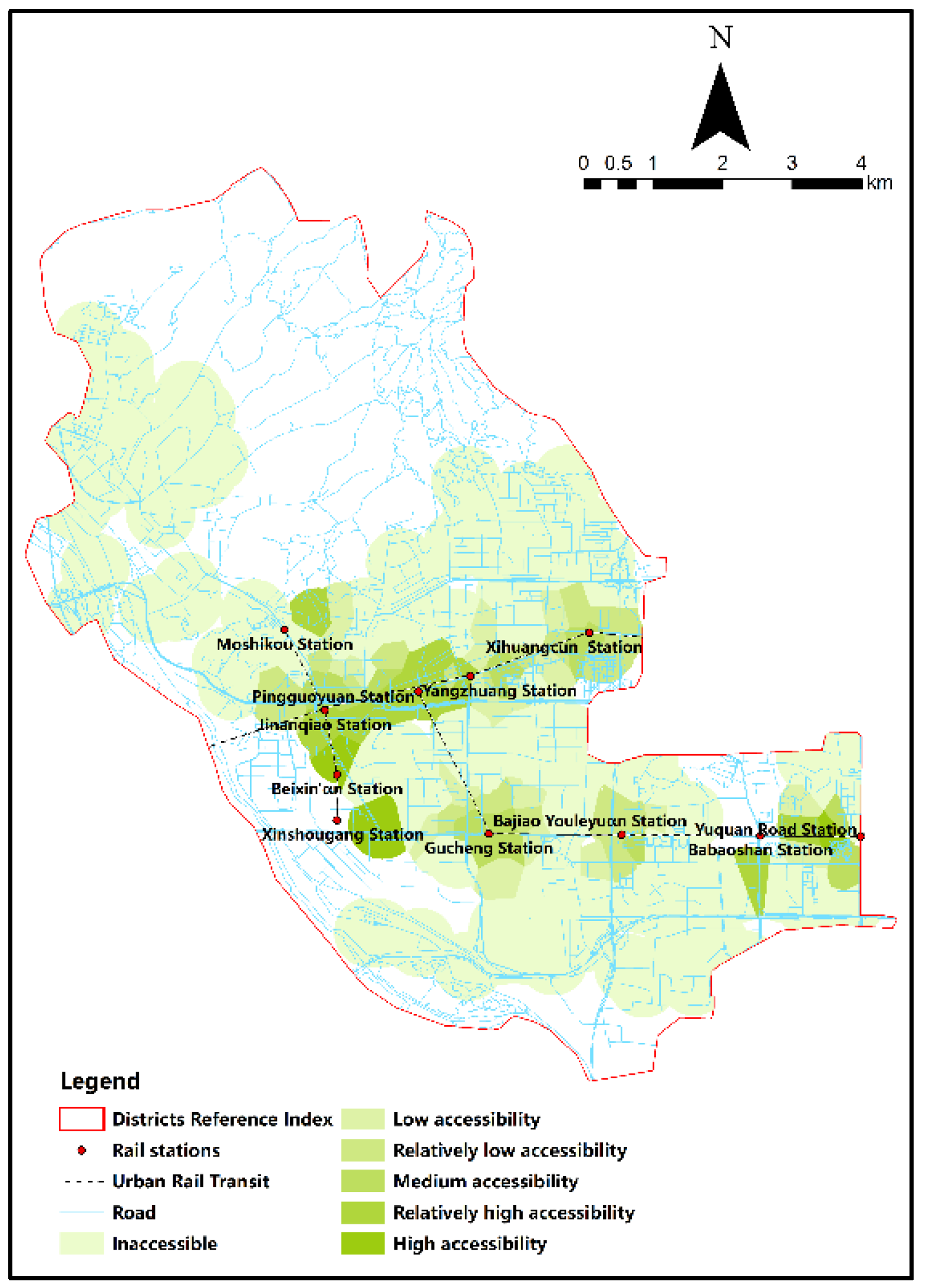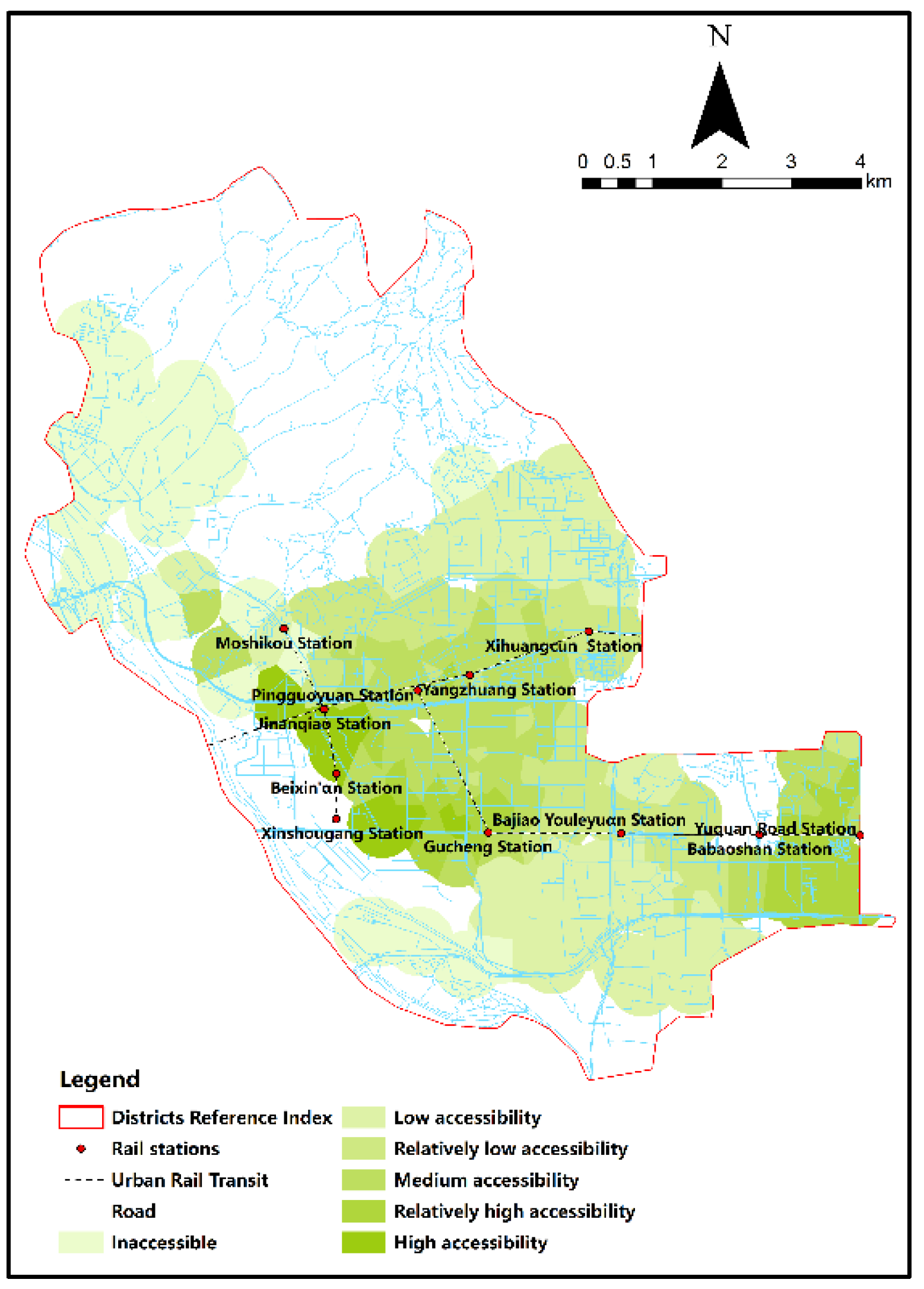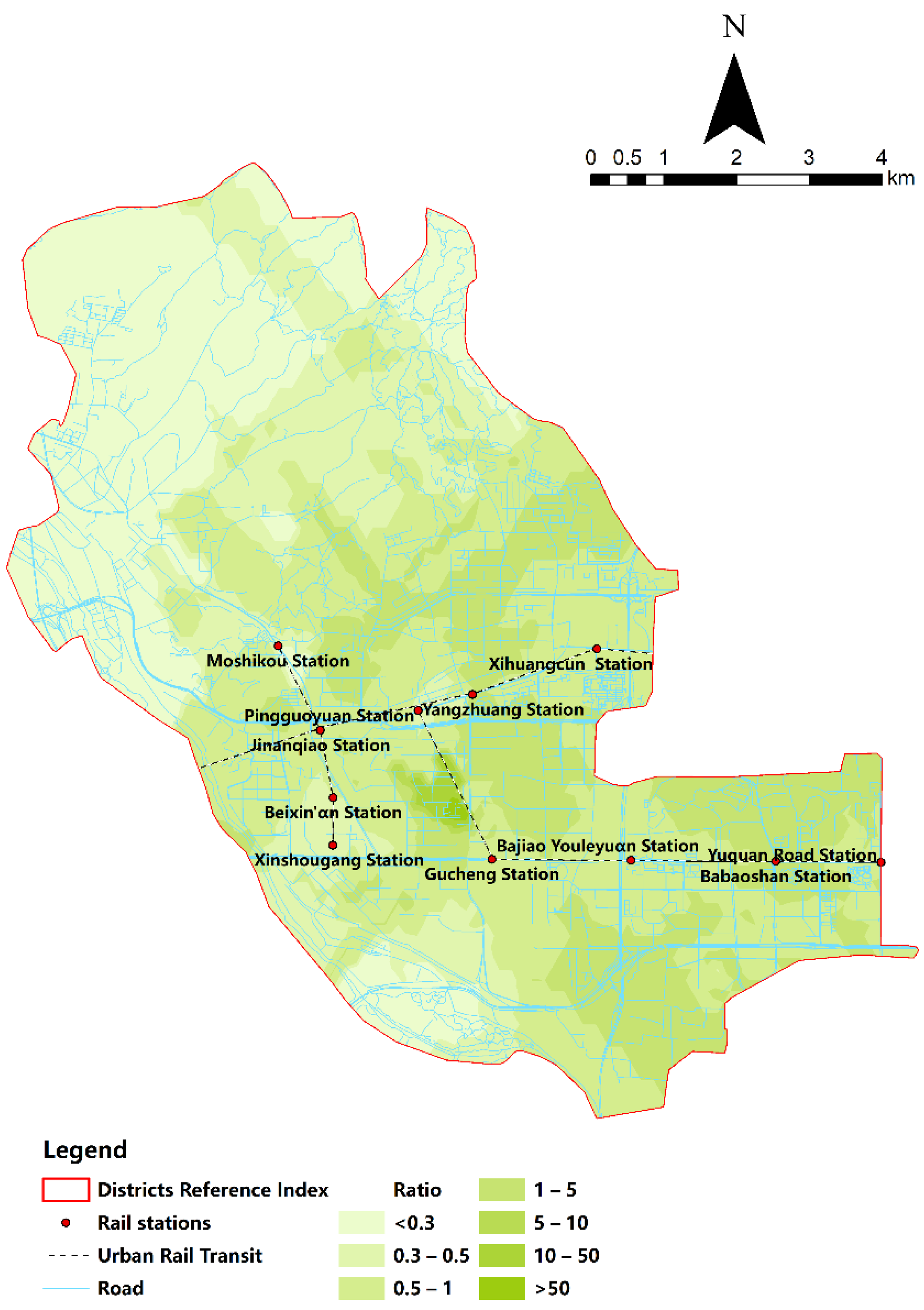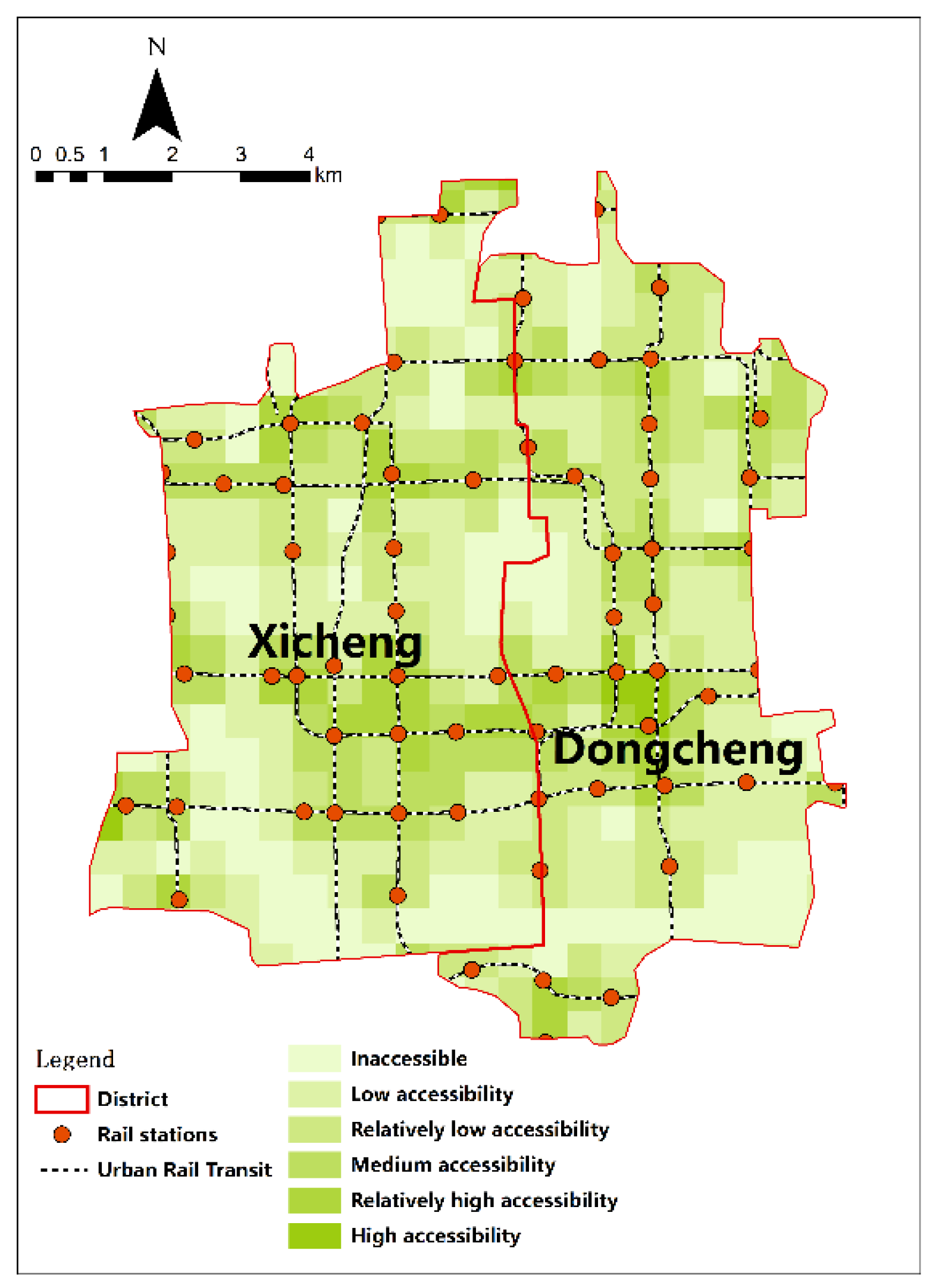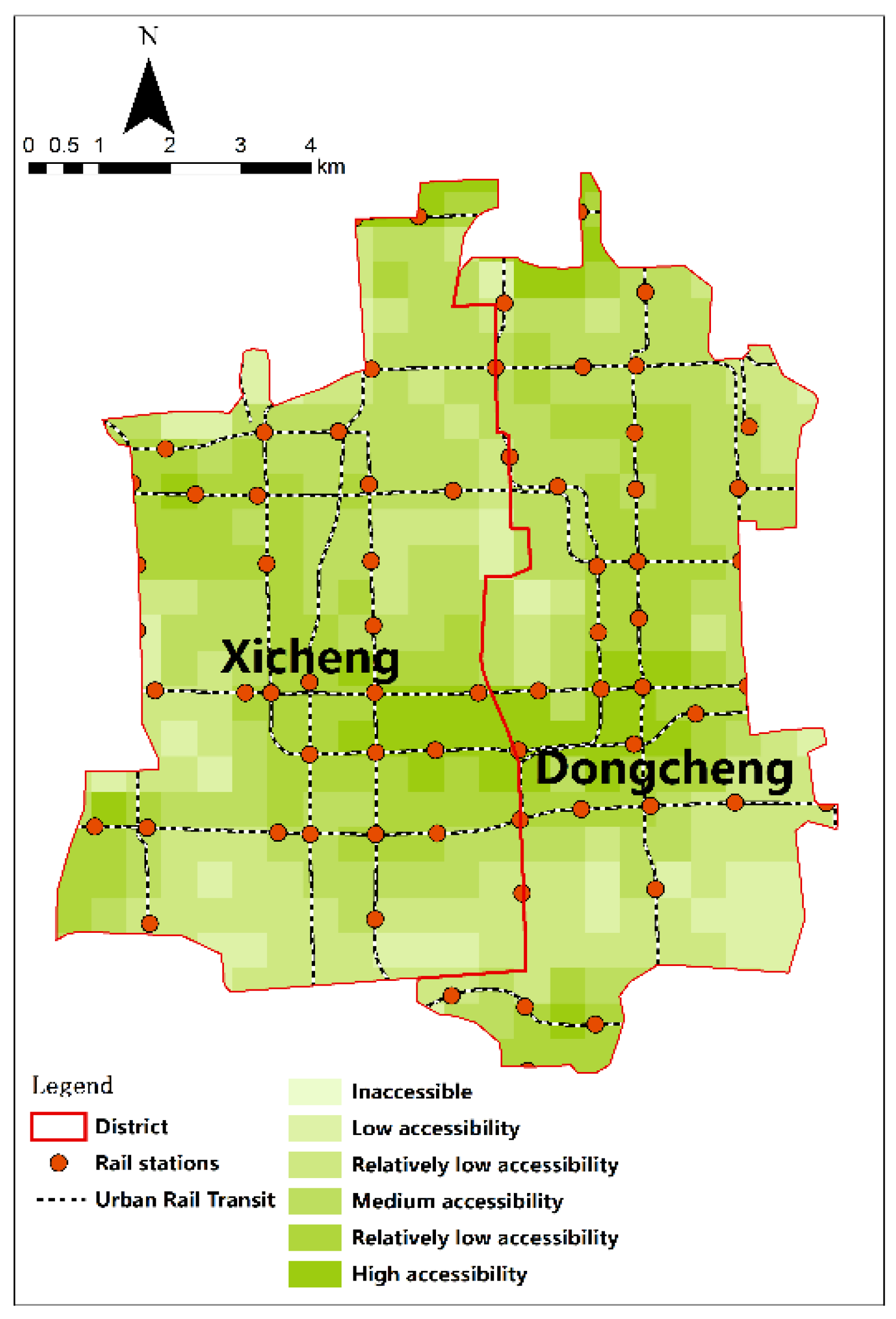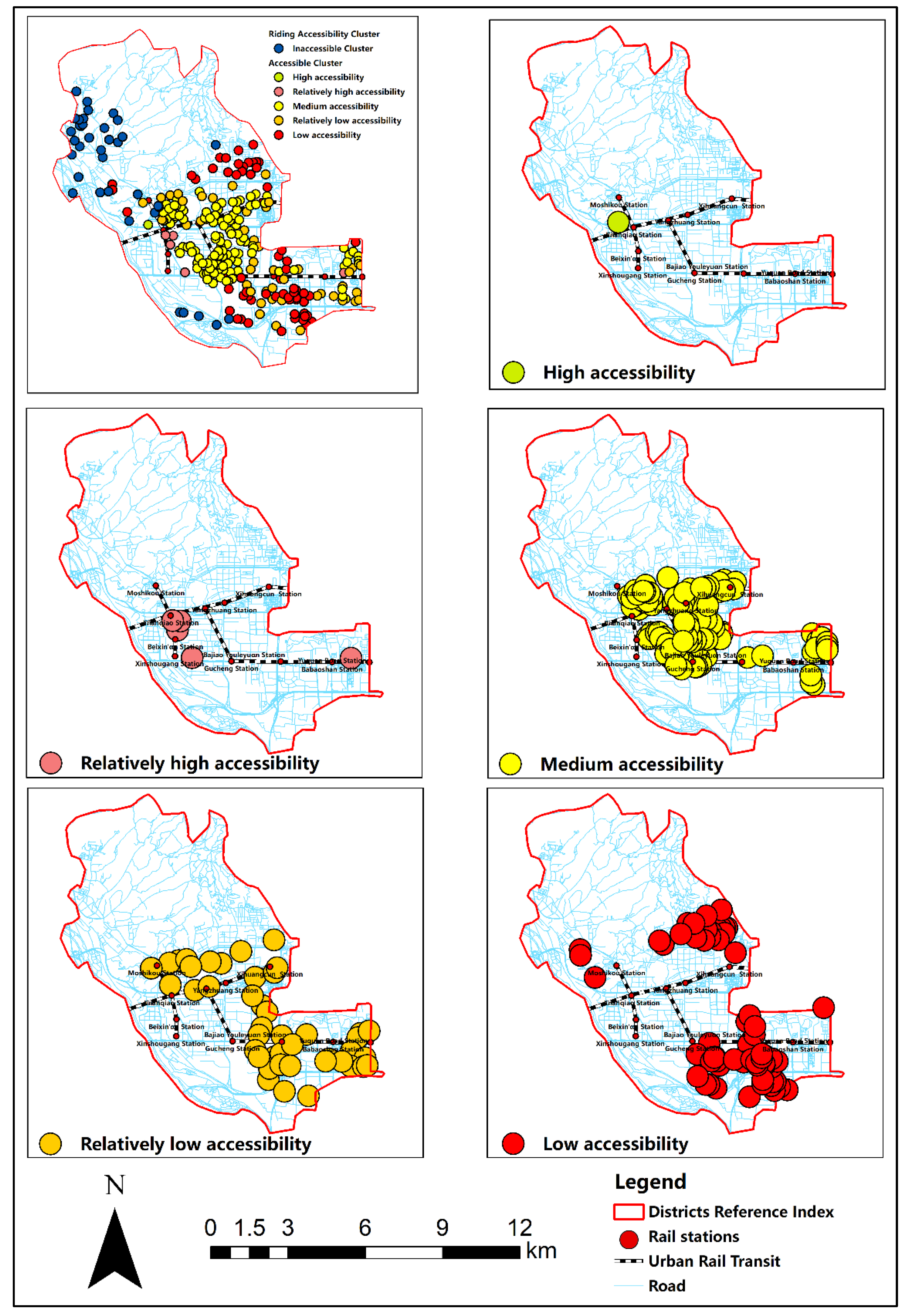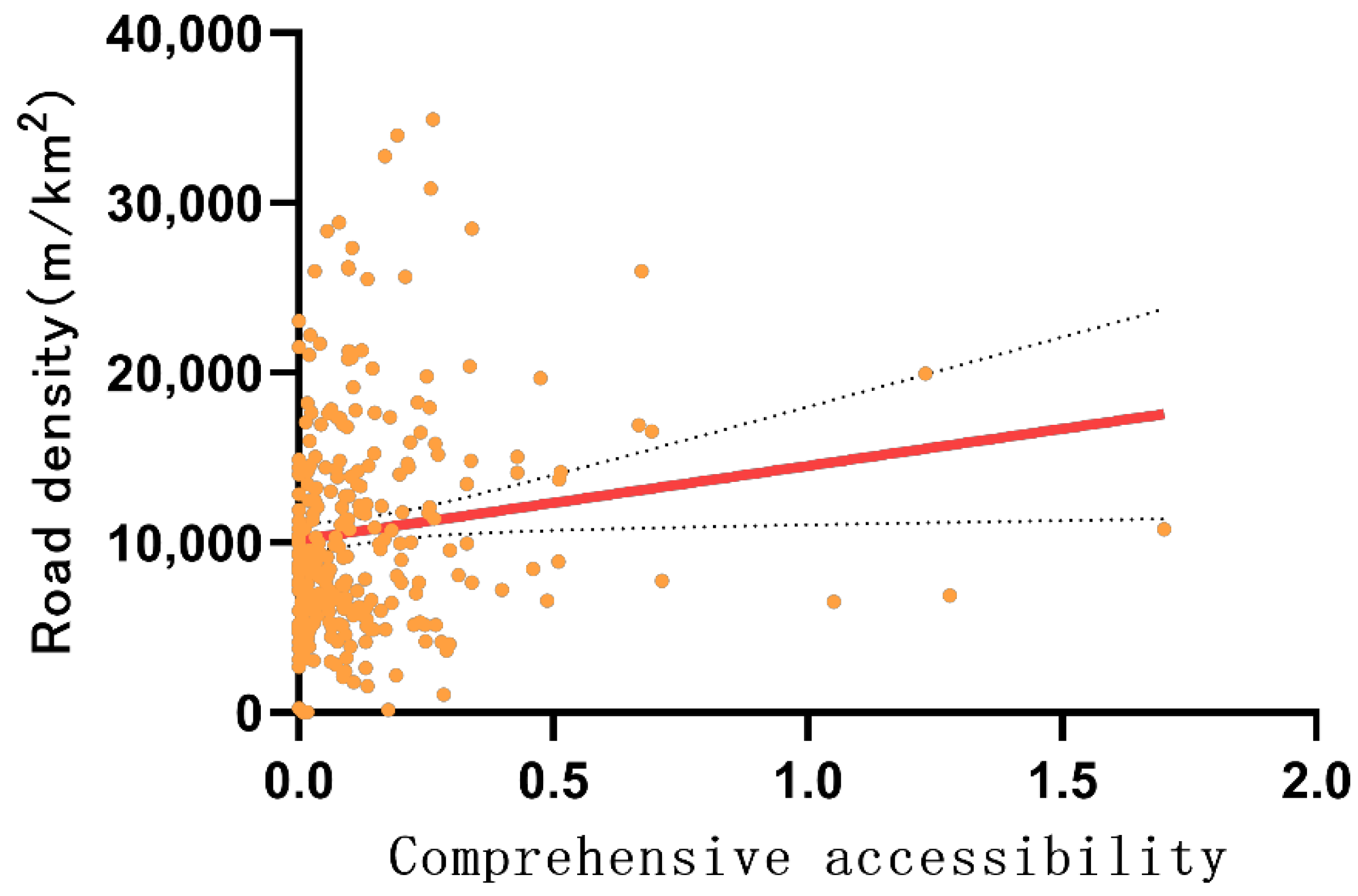1. Introduction
In large and medium-sized cities in China, the rail transit network has gradually taken shape, and it has also become the main role of urban public transportation [
1]. The accessibility of rail stations reflects the convenience of the “last kilometer” of rail transit trips. It is of great significance to improve the use efficiency of rail stations and to build a public transport system with rail transit as the core.
The study of accessibility was first applied to public service facilities. In 1959, Hansen defined accessibility, for the first time, to represent the difficulty of reaching a particular destination, which was subsequently widely used in urban and rural planning, geographical mapping and other disciplines [
2]. The study of rail transit accessibility is primarily divided into the study of rail station accessibility and rail transit network accessibility research. For example, Cheng Changxiu studied the accessibility of subway lines, transfer stations and all-terminal stations in Beijing [
3]. Wei Panyi et al. studied Beijing metro lines based on bus transfer and accessibility between rail stations [
4]. Yao Zhigang et al. optimized the linear buffer zone method, and put forward the road network distance buffer zone method and the road network attenuation method [
5]. Ma Shuhong et al. calculated the accessibility of different trip modes and stations by determining the radiation range of stations to different connection modes [
6].
From the above studies, fewer studies on rail transit accessibility focus directly on the accessibility of stations. Zuo et al. studied the relationship between the slow road network connectivity of the bus station and the bus trip [
7], and the impact of slow traffic on the accessibility of public transport is also discussed, however, the object of the study is the whole process of a bus trip [
8]. Although Wei Panzhihua studied the accessibility of the station, it mainly took the convenience of bus transfer and inter-station transfer [
4]. These studies have focused on site accessibility issues, but few studies have analyzed site accessibility from the perspective of residents’ needs.
Accessibility measurement methods usually include the coverage method, nearest distance method, gravity model method and two-step floating catchment area method. Among them, the coverage method takes the total population or coverage proportion within the service area as the standard, which has a poor effect on the spatial difference of accessibility within the service area; the nearest distance method takes the trip cost as an indicator to reflect the accessibility of residents and lacks a consideration of the impact of the site itself on accessibility. The gravity model has factors such as site supply capacity and trip cost, however, lacks consideration of residents’ needs. The two-step floating catchment area method is modified based on the gravity model. By searching and analyzing the stations (supply side) and trip starting point (demand side), respectively, it can be used to measure the accessibility of rail stations at the trip starting point and identify the low-value areas of accessibility [
9]. The traditional two-step floating catchment area method deals with the relationship between the supply side and the demand side, without distance attenuation, within the distance threshold, and it is inaccessible beyond the threshold. In the development process of this method, some scholars have improved it and added different impedance functions to make it more reasonable. The main functions are power, exponential and Gaussian [
10]. The first two functions perform slightly better because of the rapid decline at the threshold point and the Gaussian decay in the threshold range [
11,
12].
The two-step floating catchment area method has been more frequently applied to the assessment of the accessibility of various public service facilities. Among them, Hu Ang et al. used the two-step floating catchment area method to analyze the spatial distribution, supply and demand of green space in the central districts of Chengdu [
13]; Zhang Yanlin et al. analyzed the spatial accessibility and characteristics of elementary school education resources in Zhuzhou County, using the Gaussian two-step floating catchment area method and Gaode Map API [
14]; Rao Yingxue et al. used a gravity-based two-step floating catchment area method to explore the accessibility of education resources in urban areas of Wuhan City under different impact factors [
15]; Peng Jiandong et al. used the two-step floating catchment area method with multisource big data to evaluate the accessibility of elderly facilities and services in Wuhan [
16]; Yang Li et al. studied the equilibrium and accessibility of the spatial distribution of medical resources in Nanjing using the two-step floating catchment area method [
17].
In summary, the two-step floating catchment area method is primarily applied to the equilibrium and accessibility of public service facilities, such as parks and green spaces, educational resources, elderly service facilities and medical resources. However, research on the accessibility of rail transit stations uses the two-step moving search method less often, indicating that few scholars analyze the accessibility of rail stations from the perspective of supply and demand.
In addition, with the use of internet map API, scholars have begun to explore the use of big data to study the accessibility of rail stations [
18,
19,
20,
21], which has improved the accuracy and fit to daily life. By using internet map API, Xiao Bohua et al. proposed a computational method that integrates internet map data and network analysis, then used the method to analyze the urban rail transit planning scheme of Wuhu [
22]. Dai Zhi et al. used internet map open source data and path planning API to quantitatively evaluate the accessibility index, using Shenzhen rail stations as an example [
23]. Guo Peng et al. used internet map data to measure the accessibility and sensitivity analysis of green spaces in the central city of Tianjin [
24]. Zheng Zhicheng et al. used internet map services and combined multi-source big data to explore the accessibility and driving formation mechanism of Kaifeng [
25]. Qi Xiaoxing et al. used internet map POI data to analyze the spatial heterogeneity of the use of underground space in Jinan [
26]. All the above studies used internet map API and conducted relevant research analysis, which showed that the internet map API data had a better fit with reality and was more helpful for the relevant research.
The accessibility of rail transit stations can be evaluated from the perspective of supply and demand by using the two-step floating catchment area and the Gaode map API. It can complement the calculation method of rail transit station accessibility. In addition, the use of Gaode Map API for relevant data acquisition can improve the accuracy of data acquisition and the degree of fitting with real life. The evaluation method of rail transit station accessibility is refined and expanded.
3. Results and Discussion
3.1. Analysis of the Accessibility Results of Different Trip Modes
Computational analysis used 15 min of walking and 15 min of riding as thresholds, forming the analysis results into a visual figure, and the results are shown in
Figure 5 and
Figure 6. The results conclude: inaccessible region, low accessibility region, relatively low accessibility region, medium accessibility region, relatively high accessibility region, and high accessibility region.
According to the 274 demand units obtained in the previous step, when the trip mode is walking, 91 demand units can walk to the rail stations within 15 min, accounting for 33.21% of the number of demand units in the whole region. The 22 accessible demand units are above the average, accounting for 24.18% of the walking units. When the trip mode is riding, the riding time of 238 demand units to the rail transit station is less than 15 min, accounting for 86.86% of the total number of demand units in the whole region. Among them, 87 of the accessible demand units have higher accessibility than the average value, accounting for 36.55% of the number of achievable by riding (
Table 3). The results show that the overall accessibility of rail transit stations in the Shijingshan District is 254 low, and the accessibility of riding is significantly higher than that of walking.
3.2. Comparative Analysis of the Two Trip Modes
In order to further reflect the impact of the two different modes of trip on the demand unit, the results of riding are compared with the 91 demand units that can walk to the station. If the riding site accessibility is higher than walking, the ratio is greater than 1, and the inverse is less than 1 (
Table 4). As shown in the results, a total of 36 demand units have improved their accessibility after using cycling, among which three units, namely the Gucheng Ruyi community, Shougang Guxi residential area and Beijing Xixiandaicheng City, have obvious optimization effects by using cycling. The Kriging interpolation method was used in ArcGIS to visualize the comparison results (
Figure 7). It can be clearly seen that the accessibility of demand units between Gucheng Station and Pingguoyuan Station of Line 1 increased significantly after cycling. The units with reduced accessibility are mainly located near Pingguoyuan Station and Yuquan Road Station.
Through the above analysis, the conclusion is drawn: (1) Riding can improve the accessibility of stations with inadequate development and uneven distribution areas. (2) For the surrounding areas of stations with a high carrying capacity and more mature development, the same travel mode has little impact on the accessibility.
3.3. Comparative Analysis of Shijingshan with Dongcheng District and Xicheng District
In order to determine whether this method applies to rail station accessibility evaluation, the same method was used to evaluate the walking accessibility and riding accessibility of rail stations in the Dongcheng District and Xicheng District of Beijing, and the results were compared and analyzed with those of the Shijingshan District.
The Dongcheng District and Xicheng District of Beijing cover a total area of 92.54 km2 and have a resident population of 1.815 million. The area is similar to the Shijingshan District, but the resident population is much higher. There are 66 rail stations in the Dongcheng District and Xicheng District.
The final calculation shows that when the trip mode is walking, 341 demand units can walk to the rail stations within 15 min, accounting for 80.05% of the number of demand units in the whole region (
Figure 8). When the trip mode is riding, all demand units can ride to the rail stations within 15 min, accounting for 100.00% of the number of demand units in the whole region. A total of 321 units, or 94.13%, are above average in terms of walking accessibility units. There were 216 units with above-average riding accessibility, accounting for 50.70% of the number of all demand units in the area (
Figure 9). There are 277 units whose ratio of riding accessibility to walking accessibility was greater than one, indicating that 65.02% of the units could improve accessibility by riding, however, the improvement was not significant (
Table 5).
In order to more obviously analyze the results evaluated by this method, the standard deviation is used to represent the degree of balance in the accessibility evaluated results. The standard deviation of the results for the two modes of travel assessment was calculated, separately, for all cells, and these were compared; the study area with a smaller standard deviation indicated a more balanced accessibility distribution (
Table 6).
According to the calculation results, although the overall accessibility results of the Dongcheng District and the Xicheng District are better than those of the Shijingshan District, the average accessibility results are lower than those of the Shijingshan District. This indicates that the per capita rail service in the Dongcheng District and Xicheng District is lower than that in the Shijingshan District within the reach of rail transit stations, however, the overall distribution is more uniform.
3.4. Clustering Analysis of the Accessibility of Walking Trip Mode
In order to comprehensively analyze the causes of the accessibility problems of rail stations, specific improvement measures and future optimization suggestions are made clear. The IBM SPSS Statistics 23 was used to perform K-value cluster analysis on the results obtained from the two trip modes. The indicators involved in the cluster analysis included the sum of the carrying capacity of sites accessible by the demand units, the number of population in the demand units, the average time from demand units to sites, and the result value of accessibility, obtained according to the two-step floating catchment area method. The results are divided into five categories. The clustering results of walking accessibility and influencing factors are shown in
Table 7 and
Figure 10.
There are four high accessibility units, namely Yuquan Hospital Family Building (between Yuquan Road Station and Babaoshan Station), Zhonghai Huanyutianxia (between Gucheng Station and New Shougang Station), Courtyard 99 of Shijingshan Road (between Gucheng Station and New Shougang Station) and Jingshan Fu (between North Xin ‘an Station and Jin’ anqiao Station). This area has a short distance to a single large station or multiple stations. Although there is a large residential population, the supply of surrounding stations can meet the demand, thus, walking to the site has the highest accessibility.
There are 14 units with relatively high accessibility, mainly distributed around Jin’anqiao Station, Pingguoyuan station and Yangzhuang Station. The time from such areas to large sites is moderate, but the population is small and the site supply capacity is sufficient, thus achieving high accessibility.
There are 22 units of moderate accessibility. These are distributed around the octagonal amusement park station, Gucheng station and Xihuangcun Station. Although it takes a short time to walk to the site, the supply of stations cannot meet the demand; therefore, the accessibility is not high. For such areas, the carrying capacity of the stations can be appropriately increased, such as with the addition of an octagonal amusement Park station and Xihuang Village Station entrance, to further improve the walking accessibility of such areas.
There are nine relatively low accessibility units, distributed in the south area of Line 1 and the east area of Moshikou Station. This region has the largest population, however, the carrying capacity of the accessibility site is poor, the supply cannot meet the demand, and the walking time to the site is long, making the accessibility low. It can optimize the slow traffic in such areas, advocate riding trip, and reduce the trip time. Adding sites or entrances to improve the carrying capacity of the site and improve its accessibility is also a solution.
There are 42 low accessibility units, mainly distributed in the area between Line 1 and Line 6, and in the east area of the Moshikou Station and Jin’anqiao Station. The supply of such units is greater than demand and the low accessibility is caused by long walking times to the site. Additional stops can be added around such units or slow traffic can be established to reduce the trip time from such areas to the stations.
3.5. Analysis of the Clustering Results for Riding Accessibility
The results obtained from riding were clustered using the same method, as shown in
Table 8 and
Figure 11:
There is a total of one high accessibility unit, which is the first casting area of Shougang, located in the west side of Jin’anqiao Station. Although this region has the largest population, the supply and demand relationship between the station and the population is balanced, and the time to ride to the large station is short and has the highest accessibility.
There are five relatively high accessibility units, namely Courtyard 99 of Shijingshan Road (located in the east of new Shougang Station), Zhonghai Huanyutianxia, Jingshan Fu and Zhonghai Tianxiayushanfu (located near the south of Jin’anqiao Station), and Yuanlin Community–Yuquan West Street (between Yuquan Road Station and Babaoshan Station). The supply and demand relationship between such regional stations and the population is close to balance, with the shortest time to the station, and therefore, high accessibility.
There are 125 medium accessibility units, mainly distributed in the enclosed area of Line 1, Line 11 and Line 6, just north of the West Chang’an Avenue. Such areas are located around large stations, and the supply can meet the demand, but it takes a long time to ride to the station; therefore, the slow traffic system can be appropriately optimized to reduce the trip time and improve the accessibility.
There are 44 relative low accessibility units, mainly distributed around the Bajiaoy Amusement of Line 1, the surrounding area of the south side along West Chang’an Avenue, and the surrounding area on the north side of Line 6. Such areas have a short trip time, but the supply cannot meet the demand, resulting in low accessibility. The current situation can be improved by improving the carrying capacity of octagonal amusement park stations, such as increasing entrances and exits.
There are 62 low accessibility units, mainly distributed in the south side of Line 1 and the north side of Line 6. Although their riding accessibility is low, it is greatly improved compared with walking trip. Due to the long trip time, the accessibility of such unit sites is low. Stations can be added in the area of such units to improve accessibility.
3.6. Analysis of the Influencing Factors of Accessibility Distribution
In order to explore the influencing factors of rail station accessibility, the spatial correlation of station accessibility and its influencing factors were analyzed. In the above calculations, the number of the demand unit population, as well as the trip time cost, were used. Therefore, the improved two-step floating catchment area method site accessibility can not only reflect the supply and demand relationship between population and station supply capacity, but also reflect the slow traffic situation between stations and residential areas.
Comprehensive accessibility was adopted to better reflect the correlation of site accessibility and its influencing factors. In this study, comprehensive site accessibility was obtained by simply adding walking and riding accessibility.
3.6.1. Correlation Analysis of the Accessibility Distribution and Population Density
From the perspective of the supply and demand relationship, in the areas with higher population activity, the impact of site accessibility is correspondingly higher. To better understand the relationship between residential population and site service capacity, comprehensive accessibility and population density were analyzed.
As shown in
Table 9 and
Figure 12, the correlation analysis results show that the 95% confidence interval values are all greater than 0, and the two-tailed level is less than 0.001, indicating that the comprehensive accessibility of rail transit stations in the Shijingshan District has a significant positive spatial correlation with the population density of residential communities. The results show that the comprehensive accessibility of rail transit stations in the Shijingshan District harmonious with the spatial distribution of population.
3.6.2. Correlation Analysis of the Accessibility Distribution and the Road Density
Trip time can affect the accessibility of the station and, to some extent, can reflect the slow traffic around the station. The higher the road density, the smaller the corresponding block size, and the more conducive to a slow trip to the destination. Therefore, the correlation between road density and the comprehensive accessibility of rail stations is selected for this analysis, and the analysis results are shown in
Figure 13 and
Table 10. The analysis showed the positive correlation between site integrated accessibility and road density, namely, the higher the road density, the higher the integrated accessibility. Site accessibility can be improved by increasing road density.
3.7. Suggestions for Optimizing Accessibility
Through the reconstruction project of slow-moving streets in the Shijingshan District, we asked the surrounding residents for their opinions on the reconstruction plan of walking and riding roads around the stations, and we conducted a questionnaire survey (
Appendix A) on the surrounding residents, and 150 valid questionnaires were collected. Among them, 86.67% chose to go to the rail transit station by walking, and 66.92% of these people said they would choose to go to the rail transit station by riding if the riding road was optimized or increased. The questionnaire and photos (
Figure A1) of the meeting are shown in
Appendix A and
Appendix B.
Based on the above analysis, the regional accessibility optimization measures of the 11 sites in the Shijingshan District were organized, as shown in
Table 11.
The stations with relatively high accessibility are the new Shougang Station and North Xin’an Station, and the two stations are located in the Shougang Industrial Park. The small surrounding population leads to a supply that is greater than the demand; therefore, the accessibility is high, which can appropriately improve the degree of surrounding developments and increase the population.
Other site areas will mainly optimize the low accessibility areas. For areas with low walking accessibility, the main cause of low accessibility is the long walking time to the site. There are four areas in which the accessibility can be significantly improved by riding: (1) The area between Gucheng Station and Pingguoyuan Station; (2) The area between Yangzhuang Station and Pingguoyuan Station; (3) The triangle area of Pingguoyuan Station, Moshikou Station and Jin’anqiao Station; (4) The area between Babao Mountain Station and Yuquan Road Station. The accessibility of such regional stations is mainly improved by optimizing the riding environment and encouraging riding trips.
The second is the area with low cycling accessibility, which is caused by the low carrying capacity of the site and the long cycling time to the site. The representative areas are the northern area of Xihuangcun Station and the area around the Bajiao Amusement Park Station. The accessibility of the station can be improved by increasing the number of entrances and exits to improve the carrying capacity of the station and optimizing the riding environment to reduce the riding time.
4. Conclusions
Taking the rail transit station in the Shijingshan District as an example, this study analyzed the accessibility, from the perspective of supply and demand, through the path planning service provided by Amap API, using the Gaussian two-step floating catchment area method and the K-value clustering method, and finally drew the following conclusions:
(1) The supply capacity of the rail station in the Shijingshan District is calculated through the Critic weight method, which can more objectively reflect the difference in the supply capacity of the station itself, rather than the use of the station passenger flow volume. In addition, the 100 m resolution population grid in 2020 was corrected by using the seventh National Census in the Shijingshan District, and the Amap poi open platform was used as the demand unit, which improved the accuracy and timeliness of the demand unit. Compared with the straight-line distance and the OD cost matrix, the calculation accuracy of the trip distance and the time threshold is improved, and the results are more consistent with reality
(2) The walking accessibility of rail stations in the Shijingshan District is generally low, and the accessible demand unit is 33.21% of the total. If the trip mode is riding, the accessible demand unit is 86.88% of the total, showing a significant improvement. In addition, the rail stations in the whole region show the characteristics of insufficient development and uneven distribution. The results of the accessibility calculation show spatial characteristics of high accessibility in the central region and low accessibility in the north and south regions. Even if riding is adopted, only 36.55% of the residential communities with higher accessibility than the average level are accessible, and some areas are still inaccessible, such as some residential communities in Wulituo Street. Through comparing Shijingshan with Dongcheng and Xicheng, it became evident that different trip modes have little impact on the accessibility of areas with developed rail transportation. Therefore, by improving the slow trip environment and guiding residents to take riding trips, the effect of improving the accessibility of stations is more significant in areas with developing rail transportation.
(3) Through the K-value clustering method, the sum of the carrying capacity of the rail station, the population of the demand unit, the average time and accessibility results of the rail station of the demand unit are taken as the classification criteria. The demand units for rail stations in the Shijingshan District are divided into five categories for each trip mode. According to the actual situation of different stations and demand units, measures are proposed to improve the development degree around the stations, namely, to optimize the slow traffic environment and add the entrances and exits of the stations in order to improve the status quo of low accessibility demand units.
(4) The results of the correlation analysis between comprehensive accessibility and population density show a positive spatial correlation between them. This means the distribution of site accessibility is more harmonious with the distribution of population, and the distribution of accessibility is fair. Accessibility is also positively correlated with road density, suggesting that accessibility can be improved by improving road density.
(5) This study has refined the numerical relationship between supply and demand from the aspect of data source acquisition, but there are still improvements to be made in calculating the supply capacity of rail stations and the demand unit. If the supply capacity of the site is calculated with only three indicators, other factors affecting the supply capacity of the site have not been considered. In addition, with the number of population in the demand unit, the difference of population demand for rail stations is ignored.
(6) In future research, we can compare the calculation results with the difference of supply capacity formed by the actual construction of the stations and the different groups of people’s use data of the stations to verify the accuracy and practical value of the model for accessibility evaluation and provide a decision-making basis for improving the accessibility of the rail stations.

